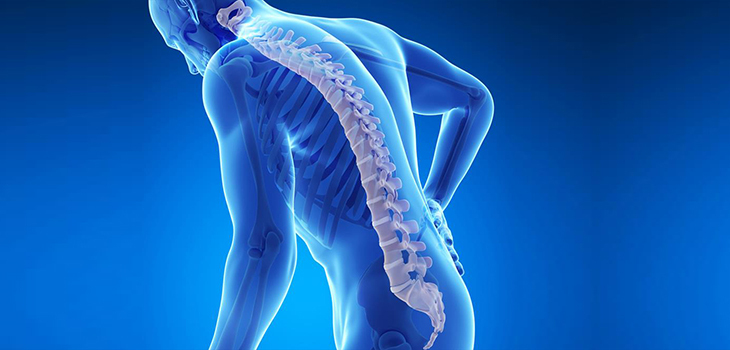OSTEOPOROSIS
1.What is Osteoporosis?
Osteoporosis, often called the 'silent disease', is a condition where the bone becomes
weak due to loss of its structure and mass. The bone loses its minerals and its micro
frame work. This makes the bone more prone to fracture.
The W.H.O has laid down diagnostic criteria to define Osteoporosis based on Bone Mineral
Density test values.
2.What are the types of Osteoporosis?
a) Senile Osteoporosis- occurring due to old age (usually beyond 70 years of age).
Ageing causes the bone to weaken due to reduced capacity to form bone. This is universal
and occurs in all individuals
b) Post-menopausal Osteoporosis- in women occurring around 50-70 years of age. Menopause
causes hormonal imbalance in women, mainly in the female hormone called Oestrogren. This
hormone , has a role in keeping the bones strong. Menopause causes a sharp fall in this
hormone and hence the resulting bone loss.
c) Secondary Osteoporosis- due to factors other than the above, can occur at any age,
most commonly due to excess alcohol, medications like glucocorticoids, anti-epileptics
(seizures medications), endocrinological abnormalities etc.

3.Does Osteoporosis increase risk of fractures?
Yes. In fact, Osteoporosis is the most common cause of fractures in individuals greater
than 60 years of age. As per studies, close to 90 lakh osteoporotic fractures occur
every year world-wide and the numbers maybe higher as many fractures go
undetected.
It is likely that these numbers may go higher in the coming years and is predicted to
reach epidemic proportions in the coming decades.
Osteoporosis makes the bone more prone to fractures by trivial falls and injuries,
asymptomatic or silent fractures of the vertebrae, many of which go unnoticed and
detected during screening.
4.Which bones are frequently affected?
All bones are affected by osteoporosis. However, there are certain locations in the body
where osteoporotic fractures are noted to occur more frequently: spine (vertebrae), hips
(proximal femur) and wrists (distal forearm) .
5.What is Bone Mass and Peak bone mass, how is it related to
osteoporosis?
Bone mass is the measure of amount of bone in the body.
Peak bone mass is the maximum bone mass attained by an individual. It is usually
attained around the second decade of life, and is between 25-30 years of age. The amount
of 'peak' bone mass or the 'maximum bone mass' an individual can make depends on his
genetics, nutritional factors, health status, physical activity , exercise, and hormonal
status during his/her initial 30 years of life.
Beyond this age, every individual loses a steady amount of bone each year. The rate of
loss maybe more in women after menopause; women approximately lose 2% of bone mass each
year after menopause.
The adult bone mass equals- (Peak Bone Mass) minus (subsequent bone loss ).
So it is clear that the adult bone mass is directly related to the peak bone mass.
6. Who are at increased risk of developing osteoporosis?
Advancing age, women, menopause, low vitamin D, poor nutritional status, sedentary
lifestyle, alcoholism, smoking, diabetes, cancer patients on chemotherapy and radiation
treatment, rheumatoid arthritis, patients treated with glucocorticoids, anti-epileptics,
etc.
7.How do you detect osteoporosis?
The parameter used to detect osteoporosis is the Bone Mineral Density (BMD). It is
basically the measure of bone mass using a type of X ray. This report is compared with
the average BMD of a reference group. The report is expressed as standard deviations (
SD) from the reference population in two ways:
T score: BMD of the patient when compared to the BMD of an
average 30 year old.
Z score: BMD of patient when compared to BMD of an average person
of similar age, sex and race.
Osteoporosis is when the BMD of an individual is below 2.5 SD of the reference
group or a T score at or below -2.5 SD.
8.Who should receive routine screening for osteoporosis?
a)All women aged 65 years and older,
b) Post menopausal women aged less than 65 years with increased risk (decided by the
clinician),
c) All men aged70 years and older,
d) High risk individuals:- patients of rheumatoid arthritis, long term steroid therapy,
diabetics, women attaining early menopause etc.
9.Is osteoporosis preventable? Is it treatable?
Osteoporosis is preventable! Adequate nutrition, good exercise, good diabetic control,
routine screening to detect high risk individuals, quitting alcohol and smoking can
prevent osteoporosis.
Once osteoporosis occurs, a variety of medications are available based on the severity
and cause of osteoporosis
10.What are the treatment options available?
The treatment depends on the cause of osteoporosis, risk of future fracture ( predicted
by various scoring systems like FRAX tool), the severity. First step is correction of
modifiable factors such as diet, nutrition, vitamin D, reducing alcohol and
smoking.
The two broad categories of drugs available are:
a)Anti-resorptive agents : which act by reducing the rate of bone loss
thereby tilting the balance towards increased bone mass. E.g., Bisphosphonates (
Alendronate, Risedronate, Ibandronate, Zoledronic acid), Denosumab, Calcitonin,
Raloxifene.
b)Anabolic agents: which act by stimulating bone formation:
Teriparatide and Abaloparatide.
They are available in a variety of formulations: oral tablets, injections, weekly,
fortnightly, or once in six months.
The average duration of therapy is atleast 12 to 24 months, beyond which, based on the
response, an alternative drug is usually recommended.
11.How does exercise help prevent osteoporosis?
Bone is constantly formed and removed from the body and this occurs throughout the life. Osteoporosis occurs when this balance tilts towards the bone resorption. Bone responds to stress and loading by formation of new bone. The easiest way to do this is by regular exercise, which includes weight bearing activities like walking, brisk walking and jogging and resistance training (lifting weights, exercises using the resistance bands). The intensity of the exercise, the duration and frequency may vary but on an average, 120 to 300 minutes of exercise per week or exercising 4 days per week is recommended.

